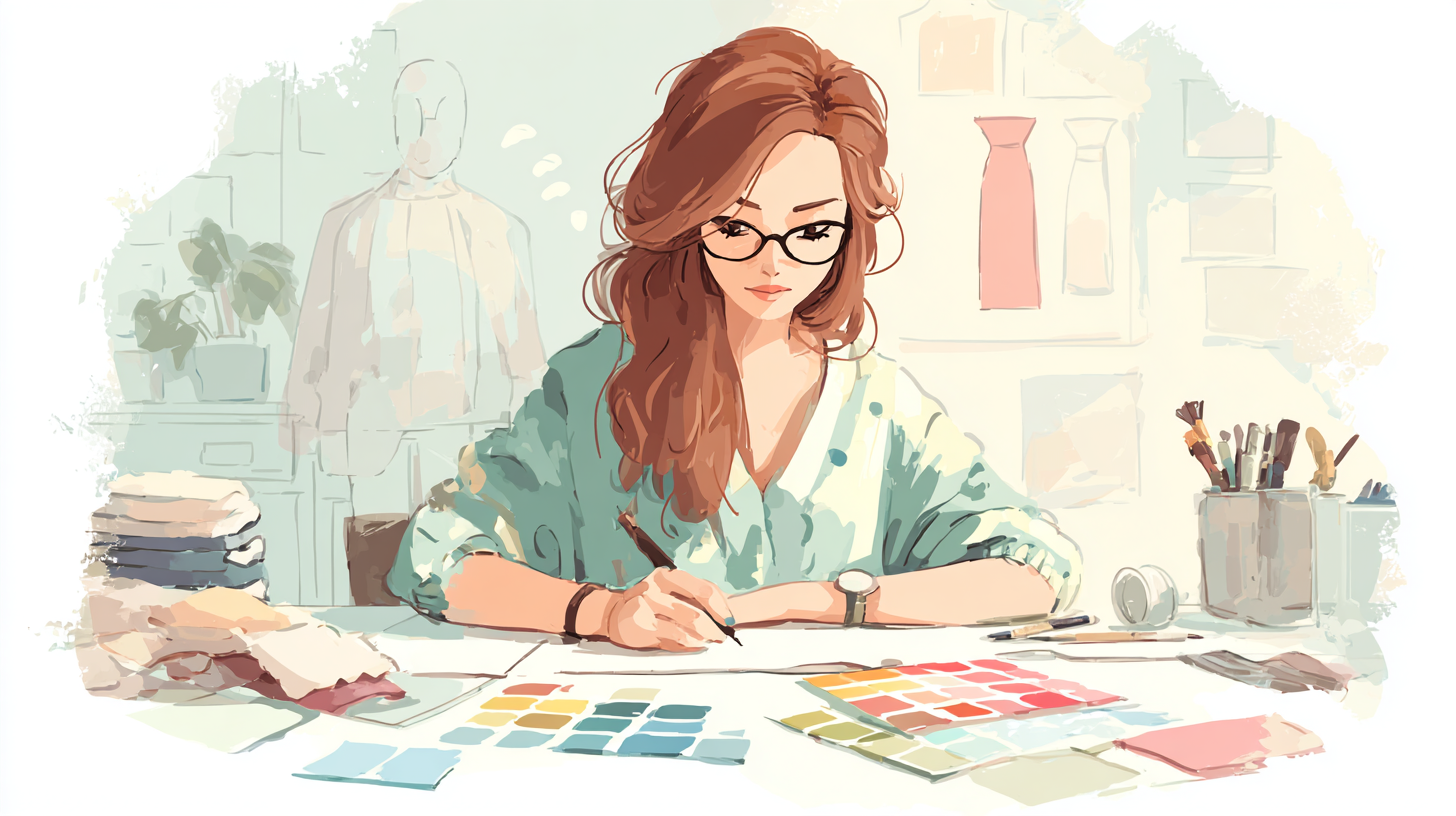A designer is a person who thinks about and creates clothes, buildings, or products.
「designer」は、洋服や建物や物の形を考えて作る人のこと。
以下は英単語 “designer” に関するストーリー型学習コンテンツです。まずは大枠の意味を理解して最後の文章で確認しましょう。
主な意味(main meaning)
| 品詞 | 発音記号 (IPA) | 意味(簡潔) | 英語例文 |
|---|---|---|---|
| 名詞 | /dɪˈzaɪnər/ | デザインする人(服、建物、製品などを考える人) | The designer created a new fashion line. |
語源(etymology)
「designer」はラテン語 designare(示す、計画する)から来ており、核となるイメージは「形を考えて形にする人」。
類義語(synonyms)
| 類義語 | 意味 | 例文 |
|---|---|---|
| creator | 作る人 | The creator of the game is very famous. |
| architect | 建築家 | The architect designed a modern house. |
| stylist | スタイルを考える人(特に服や髪) | The stylist chose the best clothes for the show. |
| planner | 計画を立てる人 | The event planner organized the wedding. |
反義語(antonyms)
| 反義語 | 意味 | 例文 |
|---|---|---|
| follower | ついていく人 | He is not a designer but just a follower of trends. |
| imitator | 真似をする人 | The imitator copied the designer’s work. |
コロケーション(collocations)
| コロケーション | 例文 |
|---|---|
| fashion designer | She wants to be a fashion designer. |
| graphic designer | A graphic designer made the company’s logo. |
| interior designer | The interior designer decorated the new office. |
| famous designer | This bag was made by a famous designer. |
2項表現(binomials)
| 2項表現 | 例文 |
|---|---|
| form and function | The designer balanced form and function in the new chair. |
| style and substance | A good designer combines style and substance. |
英語ストーリー(english story)
The Young Designer’s Challenge
Emma had always dreamed of becoming a fashion designer. Since she was a child, she loved drawing clothes and imagining people wearing them on big stages. After finishing high school, she entered a college where many future designers studied art, fashion, and business.
One day, her teacher gave the students a big assignment: they had to create a clothing line for a fashion show. Emma was excited but also nervous. She wanted her design to be unique, not just a copy of what she had seen before. “I must be a creator, not an imitator,” she told herself.
Emma started sketching her ideas. At first, she thought too much about what was popular, and her designs looked like the work of a follower. Then she remembered what her teacher always said: “A good designer combines style and substance. Clothes should not only look good, but also feel comfortable.”
Taking this advice, Emma changed her plan. She designed simple but beautiful dresses made from eco-friendly materials. She wanted to show that fashion could care about both form and function. She asked her friend Alex, who was studying to be an architect, to help her think about structure and shape.
Emma also asked a stylist friend to suggest colors that matched people’s personalities. With teamwork, her collection slowly grew into something special.
Finally, the day of the fashion show arrived. Many students were nervous. Some wore serious faces, while others smiled with excitement. Emma’s turn came, and her models walked down the runway wearing her eco-friendly dresses. The audience clapped loudly. Even a famous designer in the crowd nodded with approval.
After the show, her teacher said, “Emma, you are not just a student anymore. You are truly a designer.”
Emma felt proud, but she knew this was just the beginning. She still had a lot to learn, but she had proven to herself that she could create something original. She promised to keep designing clothes that showed both care for people and for the Earth.
和訳
若きデザイナーの挑戦
エマはずっと**ファッションデザイナー(fashion designer:洋服のデザイナー)になることを夢見ていた。子どものころから、服を描いたり、人々が大きなステージでそれを着ている姿を想像したりするのが好きだった。高校を卒業すると、彼女は多くの未来のデザイナー(designer:デザインする人)**たちが美術やファッション、ビジネスを学ぶ大学に入った。
ある日、先生が大きな課題を出した。学生たちはファッションショーのために服のシリーズを作らなければならなかった。エマはワクワクしたが、同時に不安でもあった。自分のデザインを独自のものにしたかったからだ。「私は**クリエイター(creator:創る人)**でなければならない。**イミテーター(imitator:真似をする人)**にはなりたくない」と彼女は思った。
エマはスケッチを始めた。最初は流行を気にしすぎて、彼女のデザインはただの**フォロワー(follower:流行を追う人)のようだった。しかし、先生の言葉を思い出した。「良いデザイナーはスタイルと実質(style and substance)**を組み合わせる。服は見た目が良いだけでなく、着心地も良くなければならない。」
このアドバイスを思い出し、彼女は計画を変えた。シンプルで美しいドレスをデザインし、環境に優しい素材を使った。ファッションが**形と機能(form and function)**の両方を大事にできることを示したかったのだ。
彼女は**建築家(architect:建築のデザイナー)**を目指す友人アレックスに頼み、形や構造について意見をもらった。さらに、**スタイリスト(stylist:服や髪のスタイルを考える人)**の友人に、人の性格に合う色を選んでもらった。チームワークのおかげで、コレクションは少しずつ特別なものになっていった。
ついにファッションショーの日が来た。学生たちは緊張していた。真剣な顔をしている人もいれば、興奮して笑顔を見せている人もいた。エマの番になり、モデルたちは彼女のエコ素材のドレスを着てランウェイを歩いた。観客は大きな拍手を送った。観客の中にいた**有名デザイナー(famous designer:よく知られたデザイナー)**も、うなずいて評価してくれた。
ショーの後、先生が言った。「エマ、もう君はただの学生ではない。本物の**デザイナー(designer)**だ。」
エマは誇らしく思ったが、これは始まりに過ぎないとわかっていた。まだ学ぶことはたくさんあるが、自分がオリジナルを作れると証明できた。彼女は、人や地球への思いやりを込めた服を作り続けると心に誓った。
Q&A
Q: 「designer」と「creator」の違いは何ですか?
A: 「creator」は「何かを作り出す人」という広い意味で、芸術家、発明家、作家などにも使えます。一方「designer」は、計画的に形や機能を考えて具体的に作る人を指します。つまり、「creator」はもっと広い範囲を含み、「designer」は実用的な設計やスタイルに特化した言い方です。
Q: 「designer」と「architect」の違いは何ですか?
A: 「architect」は特に建物を設計する人のことを指します。建築の専門職です。「designer」は服や家具、ロゴなども含む、もっと幅広い分野で使えます。建物に関して言えば、すべてのarchitectはdesignerですが、すべてのdesignerがarchitectとは限りません。
Q: 「designer」と「stylist」の違いは何ですか?
A: 「stylist」は服や髪型などの「見た目のコーディネート」を考える人です。一方「designer」は服そのものを作る人です。たとえば、ファッションショーでは「designer」が服を作り、「stylist」がモデルにどの組み合わせで着せるかを考えます。
Q: 「designer」と「planner」の違いは何ですか?
A: 「planner」はイベントやプロジェクトの「流れ」や「スケジュール」を計画する人です。形あるものを作るわけではありません。「designer」は形やスタイルを考えて実際に物や作品を生み出します。つまり、「planner」は計画担当、「designer」は形づくる担当です。
Q: 「fashion designer」と「graphic designer」はどう違いますか?
A: 「fashion designer」は服やアクセサリーをデザインする人、「graphic designer」はロゴやポスターなど、視覚的なデザインをする人です。どちらも「designer」ですが、対象物が違います。
Q: 「interior designer」と「architect」はどう違いますか?
A: 「interior designer」は建物の中の空間(家具や色合い、レイアウトなど)をデザインする人です。「architect」は建物全体の構造や形を設計します。建物そのものと内部の空間、という違いです。
Q: 「famous designer」と「famous creator」は同じ意味ですか?
A: 似ていますが少し違います。「famous designer」は特定の分野(服、建築、家具など)のデザインで有名な人を指します。「famous creator」は作品やコンテンツ全般で有名な人を指し、芸術家や映画監督も含まれます。



コメント